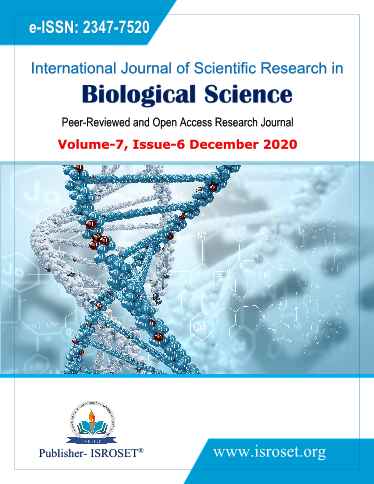Indoor Air Quality in College Laboratories: Exposure to Airborne Fungi
Keywords:
Indoor, Air-quality, Laboratories, Airborne, Fungi, Curvularia sppAbstract
The present study was undertaken to identify and find out the airborne viable fungi and their concentrations in indoor environment of college laboratories. Air sampling was conducted in Chemistry, Zoology, Botany, and Geology laboratories by using Hi-Air Sampler (Hi-media LA-002); two media strips were used for isolation of airborne fungi (PS-290 & PS-640). The average counts of total fungi isolated on two media strips were recorded maximum in chemistry laboratory (4088 CFU/m3), followed by Botany (2681 CFU/m3), Zoology laboratory (2300 CFU/m3), and the lowest recorded in geology laboratory (1622 CFU/m3). While comparing the total CFU counts of isolated fungi on two media strips, the maximum counts were recorded on PS-640 media strips (13618.75 CFU/m3), and (9,637.50 CFU/m3) recorded on PS-290 media strips. In chemistry laboratory total 31 species isolated along with Yeast and Non-sporulating fungi, followed by 29 species from Botany laboratory, 26 from Zoology and only 17 species from Geology laboratory. The total fungal counts of all the fungal species isolated from the studied laboratories were considered and found maximum CFU counts of Curvularia clavata, which is most predominant species followed by the species of Cladosporium herbarum, Curvularia geniculata, Alternaria alternata, Aspergillus niger, Alternaria solani, Curvularia lunata, Yeasts, Aspergillus flavus, Penicillium lutem, Penicillium purpurogenum, Aspergillus fumigatus, Penicillium glabrum, Alternaria brassicicola, Alternaria tenuissima, Curvularia brachyspora, Rhizopus, Mucor, and Cladosporium oxysporum.
References
Denning DW, O’Driscoll BR, Hogaboam CM, Bowyer P, Niven RM. The link between fungi, and severe asthma: a summary of the evidence. European Respiratory Journal, Vol. 27, Issue. 3, pp. 615-626, 2006.
Howard DH. Ascomycetes in: Pathogenic fungi in humans and animals. 2nd ed. Marcel Dekker Inc. New York, pp. 237-315, 2003.
Cramer J. Building-related illness in occupants of mold-contaminated houses: A case series. In: Johanning E, ed. Bioaerosols, Fungi and Mycotoxins: Health Effects, Assessment, Prevention and Control. Albany, NY: Eastern New York Occupational and Environmental Health Center, pp. 146-57, 1999.
Denning, D.W. Invasive aspergillosis. Clin Infect Dis. Vol. 26, pp. 781-803, 1998.
Ellis, M. B. Dematiaceous Hyphomycetes. Kew; Commonwealth Mycological Institute, 1971.
Raper, K.B. and Fennell, D.I. Aspergillus ustus group. - In: The genus Aspergillus. Repr. R.E. Krieger Publ. Co. 1977.
Raper, K.B. and Thom, C. A Manual of Penicillia. The Williams and Wilkins Co. Baltimore, 1984.
Nagamani, I. K. Kunwar and C. Manoharachary. Hand book of Soil Fungi. I. K. International Pvt. Ltd., 2006.
Santra, S.C. and Chanda, S. Airborne fungal flora in indoor environments of Calcutta metropolis, India. Grana, Vol. 28, pp.141-145, 1989.
Levetin E, Shaughnessy R, Fisher E, Ligman B, Harrison J, Brennan T. Indoor air quality in schools: Exposure to fungal allergens. Aerobiologia, Vol. 11, pp. 27-34, 1995.
Hyvarinen A, Meklin T, Vepsalainen A, Nevalainen A. Fungi and actinobacteria in moisture-damaged building materials–concentrations and diversity. International Biodeterioration & Biodegradation, Vol. 49, pp. 27-37, 2002.
Giri, S.K. Aeromycological survey in intramural environment of a college laboratory. Indian J. Aerobiology, Vol. 25, Issue. 2, pp. 59-64, 2012.
Gniadek A and Macura AB. Intensive care unit environment contamination with fungi. Advances in Medical Sciences, Vol. 52, pp. 283-287, 2007.
Knutsen, AP; Bush RK, Demain JG, Denning DW. Fungi and allergic lower respiratory tract diseases. J. Allergy Clin. Immunol, Vol. 129, Issue. 2, pp. 280-290, 2012.
Yuriko Nagano, Jim Walker, Anne Loughrey, Cherie Millar, Colin Goldsmith, Paul Rooney. Identification of airborne bacterial and fungal species in the clinical microbiology laboratory of a university teaching hospital employing ribosomal DNA (rDNA) PCR and gene sequencing techniques. International Journal of Environmental Health Research, Vol. 19, Issue. 3, pp. 187-99, 2009.
Ulea E, Lipsa FD, Irimia N, Balau AM. Survey of indoor airborne fungi in different educational institutions from Iasi, Romania. Lucrari Stiintifice Seria agronomie, Vol. 52, pp. 518-523, 2009.
Ahmed Khassaf Atya, Mohammed Hashim Alyasiri, Raed Altamimy and Saleem Ethaib. Assessment of Airborne Fungi in Indoor Environment for Biological Lab Rooms. J. Pure. Appl. Microbiol, Vol. 13, Issue. 4, pp. 2281-2286, 2019.
Giri, S.K. Monitoring of airborne fungi in indoor environments of reading and stock sections of college library. International Journal of Science and Research, Vol. 9, Issue. 9, pp. 1567-1573, 2020.
Hedayati, M.T. Pasqualotto, A.C., Warn, P.A., Bowyer, P. and Denning, D.W. Aspergillus flavus: human pathogen, allergen and mycotoxins producer. Microbiology, Vol. 153, pp. 1677-1692, 2007.
Macher, J., Ammann, H.A., Burge, H.A., Milton, D.K., Morey, P.R. Bioaerosols: Assessment and Control, Cincinnati, American Conference of Governmental Industrial Hygienists, pp. 1–5, 1999.
Macher, J.M., Streifel, A.J., Vesley, D., 1995 - Problem buildings, laboratories and hospitals: in Cox CS, Wathes CM (eds): Bioaerosols Handbook, New York, Lewis publishers, pp. 505–530, 1995.
Downloads
Published
How to Cite
Issue
Section
License

This work is licensed under a Creative Commons Attribution 4.0 International License.
Authors contributing to this journal agree to publish their articles under the Creative Commons Attribution 4.0 International License, allowing third parties to share their work (copy, distribute, transmit) and to adapt it, under the condition that the authors are given credit and that in the event of reuse or distribution, the terms of this license are made clear.







